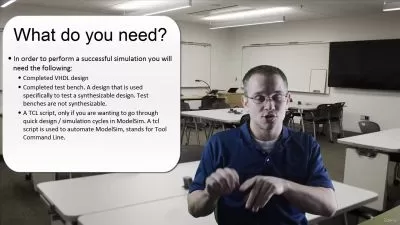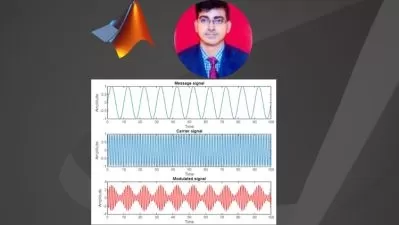Vehicle Dynamics - Matlab & Simulink Examples
5:58:51
Description
In this course you will learn basics of vehicle dynamics, forming state space matrices and simulating vehicle behavior.
What You'll Learn?
- have a basic understanding of the cornering force characteristics of pneumatic tires,
- be able to analyze the plane motions of road vehicles using the bicycle model,
- extend the use of the bicycle model to the handling analysis of articulated vehicles,
- have an insight into the the basic ideas of four wheel steering and the classical control strategies,
- be familiar with various higher order vehicle models used for handling analysis,
- understand the basic ride motions of vehicles,
- be able to model vehicles for ride studies and model road surfaces as inputs to these models,
- obtain the response of vehicle models to road inputs and evaluate the ride quality,
- be familiar with the design and optimization of passive and active suspension systems.
Who is this for?
What You Need to Know?
More details
DescriptionIn this course we will learn about main equations of a vehicle during cornering, and ride comfort. You will grasp some core logics in handling, like understeer and oversteer; where you will be able to interpret simulated results in matlab.
For the modelling of the vehicle's dynamcis equations, some basic differential algebra is required, and state space method is introduced to model vehicle systems. Derivations of underlying equations are not explained in detail, however they are shown in diagrams and main points are emphasized. In this regard, this course is a supplementary course, which focuses on simulation and analyzing part. There are great books to study vehicle dynamics in detail.
You will learn some technical skills and tricks on how to create some basic steering inputs and road profiles, and most optimum way to write matlab functions for state space generation of a vehicle model.
Since you will study theoritical framework between equations, you will be able to understand pros and cons of different models and how & when to apply them, as well as to how to approach problems.
On top of this, you will learn fundemental control methods to state-space systems in the case of vehicles, state feedback and LQRÂ strategies.
Course includes homeworks, and some of the homeworks may be challenging, in that case look for the solution and ask the parts you are interested in to me. There is repeating theme occuring in homeworks such that you will get used to this modelling approach quickly to move on your projects.
Who this course is for:
- Those who want to impove themselves on vehicle simulation and control
In this course we will learn about main equations of a vehicle during cornering, and ride comfort. You will grasp some core logics in handling, like understeer and oversteer; where you will be able to interpret simulated results in matlab.
For the modelling of the vehicle's dynamcis equations, some basic differential algebra is required, and state space method is introduced to model vehicle systems. Derivations of underlying equations are not explained in detail, however they are shown in diagrams and main points are emphasized. In this regard, this course is a supplementary course, which focuses on simulation and analyzing part. There are great books to study vehicle dynamics in detail.
You will learn some technical skills and tricks on how to create some basic steering inputs and road profiles, and most optimum way to write matlab functions for state space generation of a vehicle model.
Since you will study theoritical framework between equations, you will be able to understand pros and cons of different models and how & when to apply them, as well as to how to approach problems.
On top of this, you will learn fundemental control methods to state-space systems in the case of vehicles, state feedback and LQRÂ strategies.
Course includes homeworks, and some of the homeworks may be challenging, in that case look for the solution and ask the parts you are interested in to me. There is repeating theme occuring in homeworks such that you will get used to this modelling approach quickly to move on your projects.
Who this course is for:
- Those who want to impove themselves on vehicle simulation and control
User Reviews
Rating

Udemy
View courses Udemy- language english
- Training sessions 54
- duration 5:58:51
- Release Date 2025/01/16









